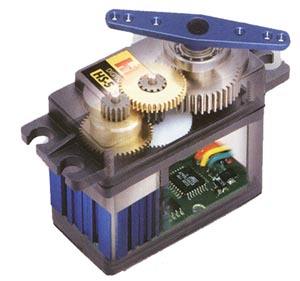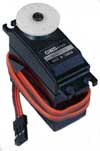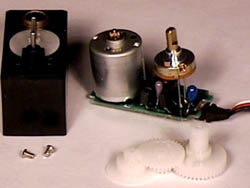 SERVO MOTORS SERVO MOTORS |
 Servo motor is a type of motors whose output shaft can be moved to a specific angular position by sending it a coded signal. The servo motor will maintain the position of the shaft as long as you keep applying the coded signal. When you change the coded signal, the angular position of the shaft will change. Servo motor is a type of motors whose output shaft can be moved to a specific angular position by sending it a coded signal. The servo motor will maintain the position of the shaft as long as you keep applying the coded signal. When you change the coded signal, the angular position of the shaft will change.
A common type of servo provides position control. Servos are commonly electrical or partially electronic in nature, using an electric motor as the primary means of creating mechanical force. Other types of servos use hydraulics, pneumatics, or magnetic principles.
Positioning servomechanisms were first used in military fire-control and marine navigation equipment. Today servomechanisms are used in automatic machine tools, satellite-tracking antennas, remote control airplanes, automatic navigation systems on boats and planes, and antiaircraft-gun control systems. Other examples are fly-by-wire systems in aircraft which use servos to actuate the aircraft's control surfaces, and radio-controlled models which use RC servos for the same purpose. Many autofocus cameras also use a servomechanism to accurately move the lens, and thus adjust the focus.
|
 Types of Servo Motors Types of Servo Motors |
 Standard servo motors have three wires, which are for power ( 4 – 6 V), ground and control. The size and shape of the servo motors are dependent on the application. RC servo motor are the common type of servo motors used in robotics and hobby applications due to their affordability, reliability, and simplicity of control by microprocessors. Standard servo motors have three wires, which are for power ( 4 – 6 V), ground and control. The size and shape of the servo motors are dependent on the application. RC servo motor are the common type of servo motors used in robotics and hobby applications due to their affordability, reliability, and simplicity of control by microprocessors.
RC servo motors are low power servos that can be powered from small batteries and other DC supplies in the range of 100 mA to 2 A.
There are also high power servo motor types which are powered from AC supplies and used in industrial applications.
|
 Configuration and Operating Principle Of Servo Motor Configuration and Operating Principle Of Servo Motor |
 Servo motors are geared DC motors with the closed-loop circuitry incorporated within them. The basic configuration of a servo motor composed of a DC motor, gearbox, potentiometer and control circuit. Servo motors are geared DC motors with the closed-loop circuitry incorporated within them. The basic configuration of a servo motor composed of a DC motor, gearbox, potentiometer and control circuit.
DC motor is used to move a gearbox with a large reduction ratio. The final shaft imposes a force on the external load and simultaneously acts on the axis of the feedback potentiometer. So, the potentiometer senses the position of the axis and sends a corresponding voltage to an operational amplifier. This voltage compared to the input voltage, that determines the desired position of the shaft, producing a voltage in the output of the comparator. This voltage powers the motor such that the shaft moves in the necessary direction to align with the angle that corresponds to the voltage applied to the input.
|
 How To Use Servo Motors How To Use Servo Motors |
The servo motors have their own characteristics like other types of motors, which are voltage, current, operating speed, torque, control pulse, resolution and pulse and weight.
Power Supply Voltage and Current :
The power supply voltage and current values are specified for each type of servo motors and depend on the application. The common RC servo motors powered from supplies in the range of 4 – 6 V and 100 mA - 2 A .
Operating Speed :
Operating speed of a servo motor is defined as the time required for the shaft to reach a specified position. Common servos have operating speeds in the range of 0,05 to 0,2 s/60 degree.
Torque :
Typical values of torques of servo motors are in the range of 0,5 to 10 kg/cm.
Control Pulse :
Control pulse is referred to the type of pulse used to position the shaft. Two main types of control pulses used in RC applications: center position in 1-2 ms and 1,25-1,75 ms.
Resolution :
It defines the precision with which the shaft is positioned when it receives an external command signal. Typical servo motors have resolutions in the range from 1 degree to 10 degree.
Size and Weight :
This characteristic is important in the mechanic design of projects. Typical RC servo motors have a weight range between 15 and 200g. |
 Advantages Of Servo Motors Over Stepper Motors Advantages Of Servo Motors Over Stepper Motors |
The basic difference between servo and stepper motors is the use of feedback. Servo motors have a position encoder attached to the drive motor that reports the actual position of the motor shaft back to the motor controller. Therefore, the servo controller may take the corrective action whenever any positioning error exists. However, stepper controllers can only issue a move command, and the user has no way to be sure that the motor has actually reached the desired position.
Servo motor systems always know exactly where the motor is at, so all step commands are executed and no lost of pulses.
Servo motors work with full torque at high speeds whereas the torque of stepper motors falls off as the motor speed increases. This problem of stepper motors is caused by the electrical time constant and poor current utilization.
Because of their high encoder resolutions, servo motors are inherently smooth, typically at least ten times finer than a stepper motor’s number of positions per revolution.
Servo systems draw power only as required, and the power drain is proportional to the load torque applied to the motor. While stepper motors must have high currents applied at all times, even while they are stationary with little or no load.
Stepper motor resolution may be increased via a process, called microstepping, in which currents are applied to the motor windings in proportionto the desired position between normal steps.
|
References:
Mechatronic Sourcebook, Newton C. Braga, Thomson Delmar Learning |
|

